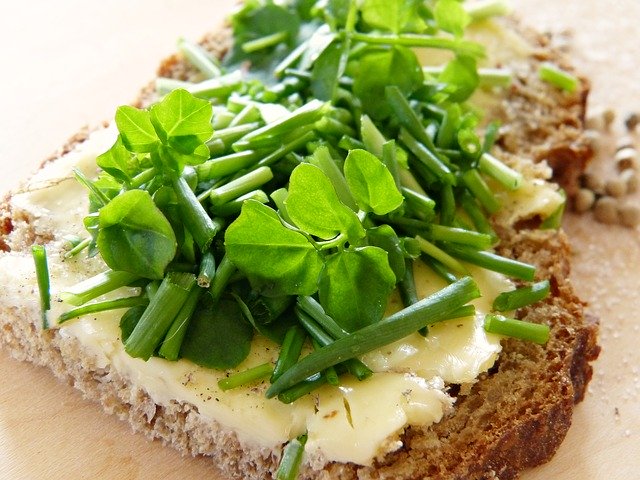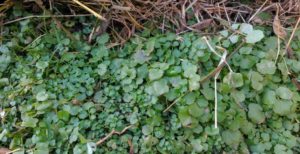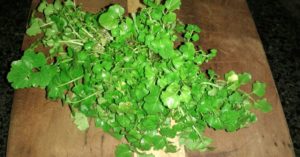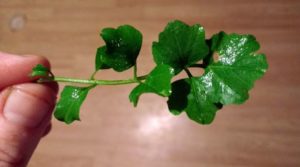This article on growing and using cresses is part of our Green of the Month series. To read the rest of the articles in the series, click here.
If you live in mountainous areas of Southern parts of the U.S., in late winter and early spring, conversations that go like this are quite common:
“Creasy greens? What’s that? Sounds like something you don’t want to have in public,” the Northerner said with incredulity.
“Honey, don’t let the name fool you. They’re delicious! My Grandma taught me how to make them,” Replied the long-time local in a thick, slow, southern drawl.
Creasy greens are what Southerners affectionately call winter cress or upland cress (Barbaraea verna). In late winter to early spring, these grow like a weed in the Appalachian mountain regions. Before the advent of access to all sorts of out-of-seasons greens at the supermarket, these used to be a pretty significant part of the late winter diet.
In my neck of the woods, these are still a pretty big deal. Creasy greens are the heralds of spring. They are the green that gets you through the final dark days of winter before your overwintering long-standing spinach starts exploding again.
You May Also Enjoy: “Growing Spinach: Pack a Punch in a Little Bunch”
The Cast of Cresses
Besides the winter cress, there are a few other cresses that also grow well in cold weather and can be enjoyed in late winter and early spring.
Hairy Bittercress
Hairy bittercress (Cardamine hirsuta) can be foraged even earlier than winter cress and often continues to grow from late fall through mid-spring. These plants are a bit smaller than winter cress and sweeter (if picked before warm weather). They also have exploding seed pods, which means they spread fast if allowed in the garden.
Generally, these are considered a weed. In some places, they are also considered invasive. Eating them is a great way to control their spread!
Watercress
Despite its name, watercress (Nasturtium officinale) does not have to grow in water, just in very moist soil. And though the leaves do look a bit similar, it has no relationship to the nasturtium flowers (Tropaeolum genus) we like to plant in our garden. (This is a perfect example of why Latin names are so important in plant identification.)
Watercress can be wild-foraged in boggy soil areas. However, it’s become so popular as a gourmet green, it’s commonly grown on purpose now.
Also, many people (me included) are afraid to harvest wild watercress because of the risk of liver fluke.1)https://www.cdc.gov/parasites/fasciola/gen_info/faqs.html Thankfully, you can avoid this problem by cooking your wild-foraged watercress before eating. Cooked watercress is amazingly delicious, too.
Garden Cress
Garden cress (Lepidium sativum) is a perennial, edible green that is prized for its medicinal seeds.2)https://www.sciencedirect.com/science/article/pii/B9780123756886100623 It’s also used as an herb, garnish, and mixed salad green. It can grow to more than 2 feet tall.
The Goods on Cresses
Although these cresses all come from different families and have slightly different growing requirements, they probably got lumped into a common cress category for good reasons. And those reasons are also why you might want to grow one or more of these delicious cresses at home.
1. Cold-Hardy Leafy Greens
For me, eating fresh greens daily is high on my list of health priorities. I keep an unheated green house and manage a winter supply of some of my other favorites like mustard, arugula, spinach, and mâche. Still, until I discovered the cresses, my lineup of leafy greens felt incomplete.
Now, I grow winter cress and watercress intentionally in my garden. I also let bittercress self-seed where it will outside the vegetable garden. These plants all do an amazing job of keeping my greens interesting through the long winter. I have yet to try garden cress, but after researching it for this article, it’s on my list of greens to try.
2. Grow Like Weeds
In the right conditions, all of these cresses can provide prolific (possibly invasive) winter and early spring greens with almost no work on your part. Watercress is only at risk for being invasive in high-nutrient boggy soil.
The others tend to do well in somewhat fertile soil. They grow better in moist, but not soggy conditions. If you let these cresses self-seed in your garden, they may take over as accidental cover crops. Luckily, you can keep them in check by eating them!
3. Versatile
All of these cresses can be eaten raw or cooked. They make pretty garnishes. They spice up salads. They are terrific as microgreens for a fancy plate-up. They make the perfect greens for tiny tea sandwiches. They are great in soups.
I could go on, but I think you get the point!
4. Phytonutrient and Vitamin Rich
As you would expect from peppery, flavorful, winter greens, these all pack a potent phytonutrient punch. They also come with loads of vitamins like A, K, C, and more. Plus, they have miniscule amounts of calories and make great filler for hearty winter appetites.
Watercress has 11 calories per 100 grams (i.e., 2.5 cups full!). Garden and winter cress have about 32 calories per 100 grams. Hairy bittercress is not really a cultivated food, so it’s hard to find exact data on calories. But we could reasonably assume the calorie count is in the same range as the garden and winter cress.
Now, for an easy way to have your first creasy green experience. Try this!
Recipe: Creasy Green Grilled Cheese
Ingredients
- 2 slices of your favorite bread
- Slices or chunks of your favorite cheese
- A large handful of any cress (wild or cultivated)
- Lots of salted butter
I am sure you know how to make a grilled cheese. But, just in case you are brand new to this, the trick is to get your cast iron pan good and hot. Then melt lots (and lots) of butter in the pan. Use that melted butter to grill both sides of both pieces of bread.
Once the bread is crispy and smothered in butter, then put your cheese and cress on one slice of bread. Cover that with the other slice of bread. Turn off the heat, cover your pan with a lid, and let the sandwich sit in the skillet so the cheese can melt. After about 3 minutes, flip your sandwich and cover again until the cheese melts to your liking.
Slice your sandwich in half, put it on a plate, garnish with a sprig of cress and serve yourself a plate of healthy greens disguised as a sinfully simple pleasure.
Note: You are welcome to use cheese, butter, and gluten-free bread substitutes for this recipe. This is cold-weather comfort food. So it’s all about what’s comfortable for you!
A Few Cautions About Cresses
1. Bolts Like Lightening
These cold-weather delights bolt like lightening as soon as the weather warms. Ups and downs in hot and cold are a flavor death sentence for the cresses. Tangy and nutty quickly turns to tannic and bitter.
Start growing these early and enjoy only until they hint at flowering.
2. Vitamin Overload
If you have health conditions that require you to restrict quantities of vitamins A or K, then exercise caution with the cresses. Even if you have no dietary limitations, as with eating any new plant, start slowly. Don’t go overboard until you know how your digestive system will handle these greens.
Also, always eat your greens as part of a balanced diet. Too much of a good thing is still too much!
3. Grows Like a Weed
The fact that these grow like weeds is the double-edged sword of easy-to-grow greens. They often self-seed and stick around eternally. If you don’t want these to be a regular part of your garden or growing areas, then do not let them flower!
How to Grow Cresses
Soil Preparation
All of these cresses require somewhat fertile soil that is consistently moist. Garden cress tolerates drier conditions and poorer quality soil than the others. Plus it’s a perennial, so give it a dedicated space.
Hairy bittercress grows well even in tiny pockets of rich, compacted soil, such as along the edge of garden beds or in rocky areas that have accumulated some organic matter. Someone even found it growing in rotting roof shingles.
Watercress requires moister conditions than the other cresses. For watercress, digging a trench in your garden bed and lining it with some kind of plastic garden material and then putting the soil on top of the liner will simulate the conditions of growing in a bog. Water the soil until it is fully saturated.
Seed Starting
All of these cresses will transplant fine. However, scattering seeds where you want them to grow several weeks before your last frost date is the easiest way to grow them. Start seeds every 2 weeks in cool weather for a continuous harvest of baby greens.
Watercress seeds are tiny and need light to germinate. The others can be pressed lightly into the soil or covered with a light coating of compost to cover.
Plant Care and Harvesting
Thin winter, bitter, and watercress to about 3-4 inches per plant and harvest young. Thinnings can be eaten (yum!). Harvest the entire plants and wash thoroughly.
Eat roots and all when young for best flavor. You can also use as come-and-cut greens, but in my experience plants tend to wear out quickly with regular harvesting.
Garden cress needs about a square foot of space. Harvest mature leaves until plant bolts. Let plants flower and seed if you want to harvest the seeds.
Remember: Don’t let these plants seed unless you want repeat visitors.
Unconventional Tips for Adventure Gardeners
I cast out seeds for the cresses in my perennial landscape areas. There, I let the plants flower and seed so they self-renew. Since these grow primarily in cool weather, they compete mostly with other permitted weeds like henbit and purple deadnettle (also delicious early season greens!)
You May Also Enjoy: “Henbit and Purple Deadnettle—The Mischievous Twins”
For unknown reasons, hairy bittercress seems unpalatable to chickens. I’ve even grown it in their run without them eating it. So, if you want a little greenery that may stand up to your laying flock, harvest unexploded seed pods and cast them out in your run area.
What Do You Think?
Now that you know about the cast of cresses, let us know what you think. Have you enjoyed any of these before? Do you plan to grow them? Any hints you want to share on using them for better health?

Tasha Greer is a regular contributor to The Grow Network and has cowritten several e-books with Marjory Wildcraft. The author of “Grow Your Own Spices” (December 2020), she also blogs for MorningChores.com and Mother Earth News. For more tips on homesteading and herb and spice gardening, follow Tasha at Simplestead.com.











COMMENTS(2)
Good stuff! Foraging wild greens is a big passion of mine – now I’m trying to domesticate some in the garden. I’d love to have everything possible growing near the house some day soon.
Thanks, Tasha! Your photo of creasy greens sent me on a merry chase to figure out if they grow in my garden already. We have a field herb called yellow rocket that looks a lot like the creasy greens. My husband loves watercress and only a few other kinds of greens. A lot of greens taste too bitter to him. He loves cheese, though, and a grilled greens and cheese sandwich would get his attention big time. We have a field herb locally called yellow rocket that appears to spread by both root and profuse seeds.. One of the common names for creasy greens is yellow rocket. The leaves on what we have look very shiny, but more rounded. It grows all year round up North where we are. Could this be the same plant? In our area, it is considered a noxious weed, and letting it grow unchecked will generate a stiff fine. I’m thinking if we ate it, we would be doing our civic duty and add enhancing our diet at the same time. Are we in luck?